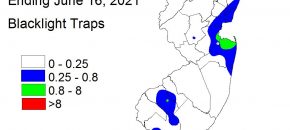Pepper production is in full swing in New Jersey and the mid-Atlantic region. Below are links to useful resources for the identification and management of important pepper diseases. Early-season Phytophthora and Pythium control Preparing for pepper anthracnose Phytophthora-tolerant and -resistant bell pepper variety trial reports Survey continuing for bacterial leaf spot and copper resistance in […]
Continue reading...Fruit IPM Information for 6/17/21
Cherry: Spotted Wing Drosophila (SWD): Cherries will need SWD protection. Effective insecticides for use on cherries include Asana, Baythroid, Cormoran, Danitol, Delegate, Entrust, Exirel, Imidan, Lambda-Cy/Warrior, Mustang Maxx, Malathion, and Verdepryn. Check the 2021Tree Fruit Production Guide for PHI’s and REI’s for U-Pick operations. rated products.
Continue reading...Spotted Lantern Fly (SLF) in the NJ Vineyards – Survey
Dear Vineyard operator, Rutgers Cooperative Extension in collaboration with NJ Center for Wine Research and Education (NJCWRE) is seeking your response regarding Spotted Lantern Fly (SLF) infestation and losses in your vineyard in previous years. Your responses are critical to understanding the distribution and impact of this invasive pest in New Jersey. If you are […]
Continue reading...Vegetable IPM Update 6/16/21

Sweet Corn Low numbers of European corn borer (ECB) moths continue to be captured, with little change from the previous week. We anticipate that this initial flight is nearing its’ end. The highest adult activity is currently Gloucester County (see map below at right). Whorl corn is the primary target for egg laying, and injury […]
Continue reading...Important resources for cucurbit disease control
The cucurbit growing season is well under way in New Jersey and the rest of the mid-Atlantic region. Below are links to useful resources for the identification and management of important cucurbit diseases. Cucurbit Powdery and Downy Mildew: A Tale of Two Pathogens The downy mildew forecasting website Preparing for cucurbit downy mildew Preparing for […]
Continue reading...Cucurbit Downy Mildew Alert – 6/16/21
Cucurbit downy mildew has been confirmed on cucumber in southern New Jersey. This is the first report of CDM in the state and region this growing season. All cucumber and cantaloupe growers should scout on a daily basis and initiate a preventative fungicide program. Remember, some CDM isolates fall into Clade I which predominately infect watermelon, […]
Continue reading...